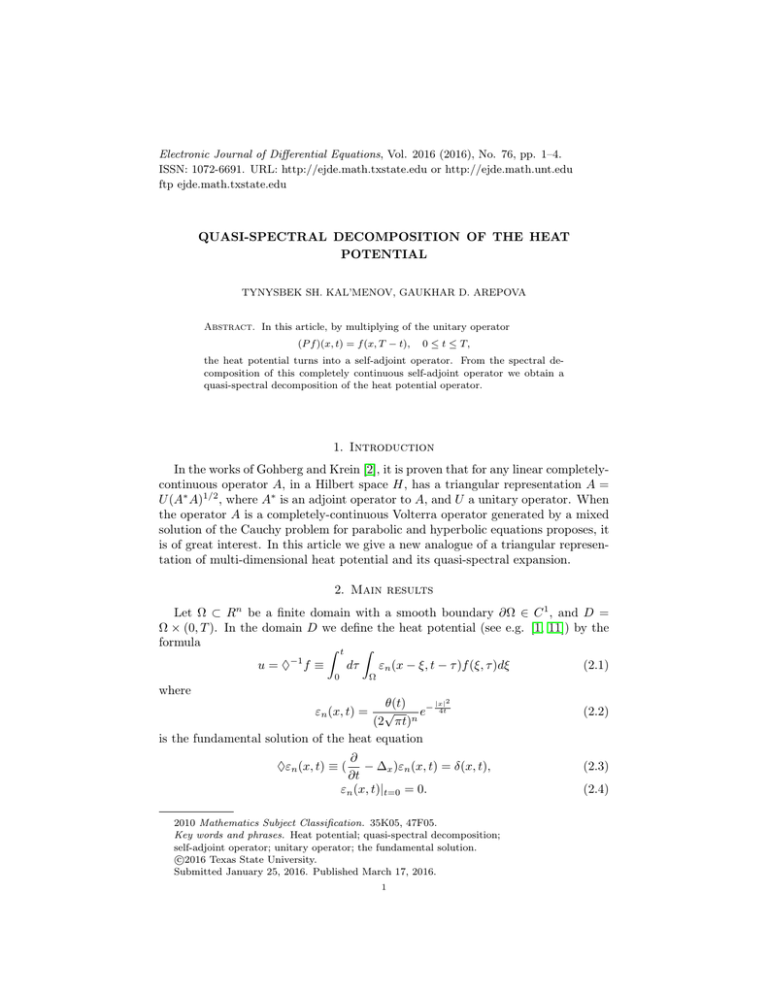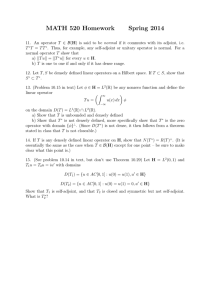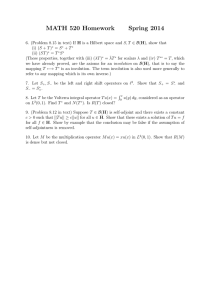Electronic Journal of Differential Equations, Vol. 2016 (2016), No. 76,... ISSN: 1072-6691. URL: or
advertisement

Electronic Journal of Differential Equations, Vol. 2016 (2016), No. 76, pp. 1–4. ISSN: 1072-6691. URL: http://ejde.math.txstate.edu or http://ejde.math.unt.edu ftp ejde.math.txstate.edu QUASI-SPECTRAL DECOMPOSITION OF THE HEAT POTENTIAL TYNYSBEK SH. KAL’MENOV, GAUKHAR D. AREPOVA Abstract. In this article, by multiplying of the unitary operator (P f )(x, t) = f (x, T − t), 0 ≤ t ≤ T, the heat potential turns into a self-adjoint operator. From the spectral decomposition of this completely continuous self-adjoint operator we obtain a quasi-spectral decomposition of the heat potential operator. 1. Introduction In the works of Gohberg and Krein [2], it is proven that for any linear completelycontinuous operator A, in a Hilbert space H, has a triangular representation A = U (A∗ A)1/2 , where A∗ is an adjoint operator to A, and U a unitary operator. When the operator A is a completely-continuous Volterra operator generated by a mixed solution of the Cauchy problem for parabolic and hyperbolic equations proposes, it is of great interest. In this article we give a new analogue of a triangular representation of multi-dimensional heat potential and its quasi-spectral expansion. 2. Main results n Let Ω ⊂ R be a finite domain with a smooth boundary ∂Ω ∈ C 1 , and D = Ω × (0, T ). In the domain D we define the heat potential (see e.g. [1, 11]) by the formula Z Z t u = ♦−1 f ≡ εn (x − ξ, t − τ )f (ξ, τ )dξ dτ 0 (2.1) Ω where |x|2 θ(t) √ e− 4t n (2 πt) is the fundamental solution of the heat equation εn (x, t) = ∂ − ∆x )εn (x, t) = δ(x, t), ∂t εn (x, t)|t=0 = 0. ♦εn (x, t) ≡ ( 2010 Mathematics Subject Classification. 35K05, 47F05. Key words and phrases. Heat potential; quasi-spectral decomposition; self-adjoint operator; unitary operator; the fundamental solution. c 2016 Texas State University. Submitted January 25, 2016. Published March 17, 2016. 1 (2.2) (2.3) (2.4) 2 T. SH. KAL’MENOV, G. D. AREPOVA For f ∈ L2 (Ω) it is easy to verify that Z t Z −1 dτ εn (x − ξ, t − τ )f (ξ, τ )dξ = f (x, t), ♦u = ♦♦ f = ♦ 0 EJDE-2016/76 u|t=0 = 0. (2.5) Ω In the work by Kalmenov, Tokmagambetov [7] (see also [3, 4, 5, 6, 9]), it is shown that the heat potential u = ♦−1 f at any f ∈ L2 (Ω) satisfies the following boundary conditions Z t Z u(x, t) ∂εn − dτ (x − ξ, t − τ )u(ξ, τ ) 2 ∂n ξ 0 ∂Ω (2.6) ∂u − εn (x − ξ, τ − t) (ξ, τ ) dξ = 0, x ∈ ∂Ω, t ∈ [0, T ]. ∂nξ Conversely, for any f ∈ L2 (D), solution of (2.5) defines the heat potential by ∂ is unit normal derivative at ∂Ω. formula (2.1). Here, ∂n ξ Note that the operator ♦−1 is completely-continuous on L2 for any f ∈ L2 (Ω), u = ♦−1 f ∈ W22,1 (D). The operator ♦−1 is a Volterra operator, i.e. it has no nontrivial eigenvectors. Let us define the operator P by (P f )(x, t) = f (x, T − t), 0 ≤ t ≤ T. (2.7) It is clear that P is a bounded self-adjoint operator satisfying P = P ∗, −1 Lemma 2.1. The operator P ♦ P 2 = I. (2.8) is a completely-continuous self-adjoint operator. Proof. Let us rewrite the operator P ♦−1 in the form Z Z T P ♦−1 f = P θ(t − τ )dτ εn (x − ξ, t − τ )f (ξ, τ )dξ 0 Ω T Z (2.9) Z θ(T − t − τ )dτ = εn (x − ξ, T − t − τ )f (ξ, τ )dξ. 0 Ω By using a direct computation for any f, g ∈ L2 (D) it can be shown that (P ♦−1 f, g)L2 (D) Z T Z = dt (P ♦−1 f )(x, t)g(x, t)dx 0 Z Ω T = Z Z T θ(T − t − τ ) dt 0 Z Ω T Z 0 Z = T Z Z = Ω T 0 Z dτ 0 f (ξ, τ )P Ω (2.10) Z θ(T − t − τ ) f (ξ, t)dx 0 εn (x − ξ, T − t − τ )f (ξ, τ )dξg(x, t)dx Ω εn (x − ξ, T − t − τ )g(x, t)dxdξ Ω Z 0 T Z θ(τ − t)dt εn (x − ξ, τ − t)g(x, t)dx dξ Ω = (f, P ♦−1 g)L2 (D) . On the other hand, (P ♦−1 f, g)L2 (D) = (f, (P ♦−1 )∗ g)L2 (D) . Because of the arbitrariness of f, g ∈ L2 (D) we obtain (P ♦−1 )∗ = P ♦−1 . (2.11) EJDE-2016/76 QUASI-SPECTRAL DECOMPOSITION This completes the proof. 3 According to the theory of regular extensions of the linear operator (Otelbaev [8] and Vishik [10]) self-adjoint differential operators are generated only by boundary conditions. Lemma 2.2. For f ∈ L2 (D) the function u = P ♦−1 f ∈ W21,2 (D) ∩ W21 (∂D) satisfies the equation ♦P u = f, (2.12) the initial condition u|t=T = 0, and the lateral boundary condition Z t Z ∂εn (P u)(x, t) + dτ ( (x − ξ, τ − t)P u(ξ, τ )dξ) − 2 0 ∂Ω ∂nξ Z t Z ∂u − dτ (εn (x − ξ, τ − t)P (ξ, τ )dτ ) = 0, x ∈ ∂Ω, t ∈ [0, T ]. ∂nξ 0 Ω (2.13) (2.14) Conversely, if u ∈ W21,2 (D) ∩ W21 (∂D) satisfies (2.12), the initial condition (2.13) and the lateral boundary condition (2.14), then u = P ♦−1 f . Proof. In view of ♦P u = f , where u ∈ W21,2 (D) ∩ W21 (∂D) satisfies the initial condition (2.13) and the lateral boundary condition (2.14), it is easy to prove (see [7]) that v = P u = ♦− 1f , where Z t Z ∂ v = ♦−1 ♦ϑ = − ∆ξ )ϑ(ξ, τ )dξ. (2.15) dτ εn (x − ξ, τ − t)( ∂τ 0 Ω It is easy to check as in [7] that Z t Z ϑ(x, t) ∂εn − + dτ ( (x − ξ, t − τ )ϑ(ξ, τ ) 2 ∂n ξ 0 ∂Ω ∂u − εn (x − ξ, τ − t) (ξ, τ ))dξ = 0, x ∈ ∂Ω, t ∈ [0, T ]. ∂nξ v =0 t=0 By taking into account v = P u we will rewrite (2.16)–(2.17) in the form Z t Z ∂εn (P u)(x, t) + dτ ( (x − ξ, t − τ )(P u)(ξ, τ ) − 2 0 ∂Ω ∂nξ ∂P u − εn (x − ξ, τ − t) (ξ, τ ))dξ = 0, x ∈ ∂Ω, t ∈ [0, T ]. ∂nξ u =0 t=T This completes the proof. (2.16) (2.17) (2.18) (2.19) Since the operator P ♦−1 is completely-continuous and self-adjoint throughout L2 (Ω), then it has a complete orthonormal system of eigenvectors ek (x, t) associated with real eigenvalues λk , λk (P ♦−1 )ek = ek . (2.20) 4 T. SH. KAL’MENOV, G. D. AREPOVA Then P ♦−1 f = EJDE-2016/76 X X (P ♦−1 f, ek )0 ek = (f, (P ♦−1 )ek )0 ek k k X X 1 ek = (f, )ek = (f, ek )ek . λk λk k (2.21) k Applying the operator P to both sides of (2.21), we obtain X 1 ♦−1 f = (f, ek )P ek . λk (2.22) k The decomposition of ♦−1 f through orthonormal system P ek is called a quasispectral expansion of the heat potential ♦−1 . This proves the following theorem. Theorem 2.3. Let ek be a complete orthonormal system of eigenvectors of the self-adjoint operator λk (P ♦−1 )ek = ek . Then, for any f ∈ L2 (D), ♦−1 f has quasispectral expansion in the form X 1 (f, ek )P ek . (2.23) ♦−1 f = λk k References [1] A. V. Bitsadze; Equations of Mathematical Physics [in russian]. Moscow: Nauka (1982). [2] I. C. Gohberg and M. G. Krein. Introduction to the theory of linear nonselfadjoint operators. Translated from the Russian by A. Feinstein. Translations of Mathematical Monographs, Vol. 18. American Mathematical Society, Providence, R.I., 1969. [3] T. Sh. Kal’menov, D. Suragan; To spectral problems for the volume potential. Doklady Mathematics, 80 (2) (2009), pp. 646-649. [4] T. Sh. Kal’menov, D. Suragan; A boundary condition and Spectral Problems for the Newton Potentials. Operator Theory: Advances and Applications, 216 (2011), pp. 187-210. [5] T. Sh. Kal’menov, D. Suragan; Transfer of Sommerfeld radiation conditions to the boundary of a bounded domain. Zh.Vychisl.Mat. Mat. Fiz., 52 (6) (2012), pp. 1063-1068. [6] T. Sh. Kal’menov, D. Suragan; Boundary conditions for the volume potential for the polyharmonic equation. Differential Equations, 48 (4) (2012), pp. 595-599. [7] T. Sh. Kal’menov, N. E. Tokmagambetov; On a nonlocal boundary value problem for the multidimensional heat equation in a noncylindrical domain. Siberian Mathematical Journal, 54 (6) (2013), pp. 1024-1029. [8] B. K. Kokebaev, M. Otelbaev, and A.N. Shynybekov; On questions of extension and restriction of operators [in russian]. Dokl. Akad. Nauk SSSR, 271 (6) (1983), pp. 1307-1310. [9] D. Suragan, N. E. Tokmagambetov; On transparent boundary conditions for the high-order heat equation. Siberian Electronic Mathematical Reports, 10(1) (2013), pp. 141-149. [10] M. I. Vishik; Boundary problems for elliptic equations degenerating on the boundary of a region [in russian]. Mat.Sb.(N.S.), 35(77) (3) (1954), pp. 513-568. [11] V. S. Vladimirov; Equations of mathematical physics [in russian]. Moscow: Nauka (1981). Tynysbek Sh. Kal’menov Institute of Mathematics and Mathematical Modeling, 125 Pushkin str., 050010 Almaty, Kazakhstan E-mail address: kalmenov@math.kz Gaukhar D. Arepova Institute of Mathematics and Mathematical Modeling, 125 Pushkin str., 050010 Almaty, Kazakhstan and Al-Farabi Kazakh national university, 71 Al-Farabi ave., 050040 Almaty, Kazakhstan E-mail address: arepova@math.kz







